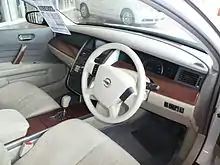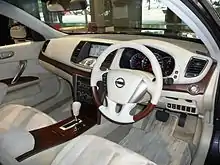Nissan Teana
The Nissan Teana is a mid-size sedan produced by Japanese automobile manufacturer Nissan. It is exported as the Nissan Maxima and Nissan Cefiro to certain markets. It replaces the Nissan Bluebird, Laurel and Cefiro. It shares a platform with the Nissan Maxima and Nissan Altima which are sold in North America, as well as the Japanese market Presage minivan. The Teana has been available in East Asia, Russia, Ukraine, South Asia, Southeast Asia, Australia, New Zealand, Latin America and the Caribbean.
| Nissan Teana | |
|---|---|
.jpg.webp) | |
| Overview | |
| Manufacturer | Nissan |
| Production | 2003–2020 |
| Body and chassis | |
| Class | Mid-size car |
| Body style | 4-door sedan |
| Layout | Front-engine, front-wheel-drive Front-engine, all-wheel-drive |
| Chronology | |
| Predecessor | Nissan Bluebird Nissan Laurel Nissan Cefiro Nissan Maxima QX (Europe) |
| Successor | Nissan Altima (L34) |
As of 2007 the Teana shares its platform with its French cousin, the Renault Laguna and Renault Latitude in most of Europe, the Middle East and Africa, and in Southeast Asia as the Renault Samsung SM5.
With the introduction of the Teana, Nissan continued the J lineage for the model codes (J31 and J32) from the Nissan Maxima (J30). Starting with the introduction of the third generation in 2013, the Teana is now a badge engineered version of the North American Altima.
The name "Teana" is from that of a small village in Italy, sharing a naming influence for the Nissan Murano, another city in Italy, which appeared at the same time.
First generation (J31; 2003)
| First generation (J31) | |
|---|---|
 | |
| Overview | |
| Also called | Nissan Maxima Nissan Cefiro Renault Samsung SM7/SM5 |
| Production | 2003–2008 2004–2009 (Thailand) |
| Assembly | Japan: Kanda, Fukuoka (Nissan Shatai) China: Xiangfan[1] South Korea: Busan (RSM) Taiwan: Miaoli (Yulon Motors) Thailand: Samut Prakan[2] |
| Body and chassis | |
| Platform | FF-L platform |
| Powertrain | |
| Engine | Petrol: 2.0 L QR20DE I4 2.3 L VQ23DE V6 3.5 L VQ35DE V6 |
| Transmission | 4-speed Jatco automatic 6-speed Jatco CVT with manual shift mode (2008) |
| Dimensions | |
| Wheelbase | 2,775 mm (109 in) |
| Length | 4,770–4,845 mm (188–191 in) |
| Width | 1,765 mm (69 in) |
| Height | 1,475–1,495 mm (58–59 in) |
| Curb weight | 1,460–1,540 kg (3,219–3,395 lb) |

_Ti_sedan_(2018-10-30)_01.jpg.webp)
_Ti_sedan_(2018-10-30)_02.jpg.webp)
_Ti_sedan_(2015-07-09)_02.jpg.webp)

The J31 series Teana was first introduced in February 2003 to the Japanese market as a sedan companion to the Nissan Murano with both vehicles exclusive to Japanese Nissan dealerships called Nissan Red Stage. It replaced the Nissan Bluebird and Nissan Cefiro in Japan, where it was considered one level below the Nissan Skyline. This was because the exterior dimensions and engine displacement exceed regulations, and Japanese buyers are liable for additional costs as a result. The car was introduced with an optionally available internet-based, telematics and GPS navigation system called CarWings to Japanese drivers only.
The J31 Teana also follows the same chassis number pattern as the Nissan Maxima (J30).
In much of the world, the Teana is Nissan's largest front wheel drive sedan, while the Skyline and Fuga are rear-wheel drive, with optional all-wheel drive.
It was introduced a month later to other Asian markets like Singapore. In 2004, the car arrived on European shores replacing the Nissan Maxima QX.
Powering the Teana was either a 1998 cc, 2349 cc or 3498 cc engine which matched to automatic transmission. Trim levels were 200JK, 230JK, 230JM and 350JM. The car was based on the Nissan FF-L platform. In December 2005, the Teana received new headlights and taillights, chrome trimming on the bumpers, enlarged foglights, front legrests and newly designed gauges. The car was also shortened slightly, and the clear rear turn signals were replaced by amber ones. XTronic CVT was also mated to all the engines.
In mainland China, the Teana was manufactured by the Dongfeng Motor Company, a joint venture with Nissan. In Taiwan it is manufactured by Yulon Motor. In the neighbouring country of Pakistan, the Teana was known as the Cefiro and was assembled in Karachi. Additionally, it is sold in India, Russia, Ukraine as well as in New Zealand and Australia where it competes with the locally produced Mitsubishi 380 and Toyota Aurion under the Maxima badge. The first generation Teana was also assembled in Thailand for sale in the ASEAN market.
The Renault Samsung SM7 of South Korea is built on the Teana platform. In January 2005, Renault Samsung announced a lower-specification version of the Teana which it is sold as the second generation (A34R) Renault Samsung SM5 and, from 2008, as the Renault Safrane.
In some countries, the 200JK was not sold. Instead, the 230JK, basically a 230JM without the VQ23DE engine was sold. In Australia, the car was sold in ST-L, Ti and Ti-L guises, but the Ti-L model was dropped after the facelift in 2005.
In 2008, Nissan discontinued production of the J31.
Engines and specifications
The first generation Teana utilized a number of engines, namely the QR20DE, VQ23DE and a slightly detuned version of the VQ35DE.
| Trim level | Compression ratio | 0–100 km/h (0-62 mph) | Engine code | Capacity | Curb weight | Turning radius | Max. Power kW (PS/bhp) at rpm | Torque |
|---|---|---|---|---|---|---|---|---|
| 200JK | 10.0 | 12.1 seconds | QR20DE | 1997 cc | 1,450 kg (3,197 lb) | 5.3 m (210 in) | 100 kW (136 PS; 134 hp) at 5,200 rpm | 189 N⋅m (139 lb⋅ft) at 4,400 rpm |
| 230JM | 9.8 | 9.3
seconds |
VQ23DE V6 | 2349 cc | 1,540 kg
(3,395 lb) |
5.5 m (217 in) | 127 kW (173 PS; 171 hp) at
6,000 rpm |
221 N⋅m (163 lb⋅ft) at 4,400 rpm |
| 350JM (Ti) | 10.3 | 7.6
seconds |
VQ35DE V6 | 3498 cc | 1,585 kg (3,494 lb) | 5.7 m (220 in) | 180 kW (245 PS; 241 hp) at 6,000 rpm | 318 N⋅m (235 lb⋅ft) at 3,600 rpm |
Second generation (J32; 2008)
| Second generation (J32) | |
|---|---|
 | |
| Overview | |
| Also called | Nissan Maxima (Australia and New Zealand) |
| Production | 2008–2013 2008–2019 (Taiwan) 2009–2015 (Iran) |
| Assembly | Japan: Kanda, Fukuoka (Nissan Shatai) Angola China: Xiangfan[1] India: Chennai Iran: Tehran (Pars Khodro) Malaysia: Serendah (TCMA) Russia: Saint Petersburg Taiwan: Miaoli (Yulon Motors) Thailand: Samut Prakan |
| Body and chassis | |
| Platform | Nissan D platform |
| Powertrain | |
| Engine | Petrol: 2.0 L MR20DE I4 2.5 L QR25DE I4 2.5 L VQ25DE V6 3.5 L VQ35DE V6 |
| Transmission | Jatco JF010E CVT (Ratios: 2.371–0.439) |
| Dimensions | |
| Wheelbase | 2,775 mm (109 in) |
| Length | 4,850 mm (191 in) |
| Width | 1,795 mm (71 in) |
| Height | 1,475–1,500 mm (58–59 in) |
| Curb weight | 1,480–1,570 kg (3,263–3,461 lb) |

Nissan revealed the second generation, redesigned Teana at the 2008 Beijing Auto Show.
The new Teana is based on the Nissan D platform also used by the new North American Nissan Maxima and Nissan Altima. Engine choices include a 3498 cc V6, a 2495 cc V6, a 2488 cc in-line four and 1997 cc in-line four, all with a continuously variable transmission. The car's design was previewed by the Intima concept car shown in October 2007.
The car was launched in Japan, Taiwan, India, Iran, Mauritius, Russia, China, Brunei, Bolivia, Chile, Colombia, Trinidad and Tobago, Thailand, Singapore, Philippines, Indonesia, Malaysia, New Zealand and Australia.
This generation was not sold in Europe, where its French cousin, the Renault Laguna was offered, alongside the longer Renault Latitude (a North American Maxima being introduced to Europe).
Nissan continues to offer an optionally available internet-based, telematics and GPS navigation system called CarWings to Japanese drivers only.
Badging

The first-generation Teana was sold under the name of Nissan Cefiro in Hong Kong, Singapore, Mauritius, Brunei, Sri Lanka, Latin America & Caribbean while it was sold under the name of Teana in Japan, Thailand, Philippines, India, Taiwan, Malaysia, Indonesia & China. The car is known as the Maxima in Australia & New Zealand. The Teana shares most of the platform and mechanicals with its North American cousin, the Altima which is built and sold primarily in North America. The J32 has been sold in Australia as a Maxima since June 2009 with model designations of 250 ST-L, 350 ST-S and 350 Ti. These models have features unique to Australia & New Zealand including alloy wheel design, rear spoiler and interior upholstery fittings. In late 2011, all three Australian models received an equipment upgrade, with prices remaining unchanged. The Cefiro name has been discontinued on the second-generation line with the exception of the Bruneian market.
Specifications
The second generation Teana utilized different engines, namely the MR20DE (successor of the QR series), VQ25DE and the VQ35DE, which was tweaked to produce 20 more PS. Also Japan Domestic Model "FOUR" (AWD) used QR25DE engine.
| Trim level | Max. Power bhp(kW) at rpm | Max. Torque | 0–100 km/h (0-62 mph) | Engine code | Capacity |
|---|---|---|---|---|---|
| 200XL *China market | 134 bhp (100 kW; 136 PS) at 5600 rpm | 190 N⋅m (140 lb⋅ft) (19.4 kg-m) at 4400 rpm | 11.8 seconds | MR20DE L4 | 1997 cc |
| 250XV | 183 bhp (136 kW; 186 PS) at 6000 rpm | 232 N⋅m (171 lb⋅ft) (23.7 kg-m) at 4400 rpm | 9.0
seconds |
VQ25DE V6 | 2495 cc |
| 250XL/XE FOUR *Japan market | 165 bhp (123 kW; 167 PS) at 5600 rpm | 240 N⋅m (180 lb⋅ft) (24.5 kg-m) at 4000 rpm | QR25DE L4 | 2488 cc | |
| 350XV | 248 bhp (185 kW; 251 PS) at 6000 rpm | 335 N⋅m (247 lb⋅ft) (34.2 kg-m) at 4400 rpm | 7.1
seconds |
VQ35DE V6 | 3498 cc |
Third generation (L33; 2013)
The third generation Teana was introduced in 2013 to some markets, essentially being a rebadged version of the North American Nissan Altima.
_2.5XV_sedan_(2016-01-03).jpg.webp) Third generation (L33)
Third generation (L33)_2.0XL_sedan_(2016-01-06)_02.jpg.webp)
_interior.JPG.webp)
References
- "Nissan. Nissan in China". Car-cat.com. Archived from the original on 18 April 2012.
- "Nissan. Nissan in Thailand". Car-cat.com. Archived from the original on 22 December 2010.
- "Thailand cars sales report 2014". HeadlightMag.com. Thailand. Retrieved 24 Oct 2018.
- "Thailand cars sales report 2015". HeadlightMag.com. Thailand. Retrieved 24 Oct 2018.
- "Thailand cars sales report 2016". HeadlightMag.com. Thailand. Retrieved 24 Oct 2018.
- "Thailand cars sales report 2017". HeadlightMag.com. Thailand. Retrieved 24 Oct 2018.
External links
| Wikimedia Commons has media related to Nissan Teana. |
- (in Japanese) Official Japanese site